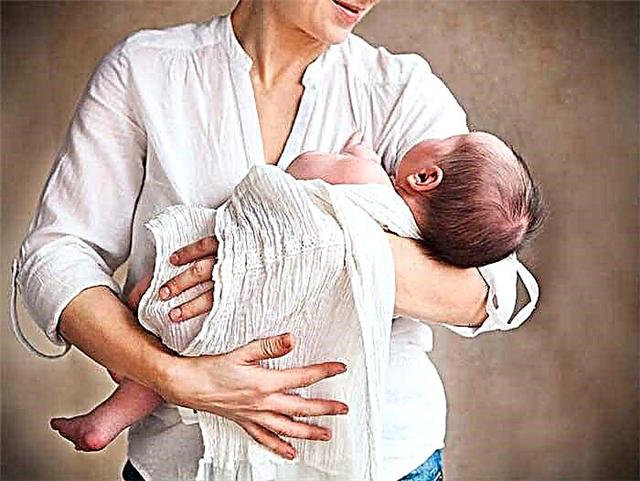Sudden Infant Death Syndrome (SIDS) is every parent's worst nightmare. This can happen unexpectedly. The worst part is that science cannot tell why this is happening. So one of the few things you can do is arm yourself with the right knowledge about this phenomenon.
Newly minted parents do their best to keep their children healthy. But sometimes a child who appears perfectly healthy dies for no apparent reason.
When a baby dies before 1 year old, it is sudden infant death syndrome (SIDS). Since this condition often occurs during sleep, the term “cradle death” can also be heard.
SIDS is defined as the sudden death of an infant younger than 1 year of age that remains unexplained after careful investigation of cases, including performing a full autopsy, examining the site of death, and reviewing the clinical history. Cases that do not meet this definition, including those without a posthumous investigation, should not be classified as sudden infant death; episodes involving an autopsy and a thorough investigation, but remain unresolved, may be designated as vague or unexplained.
Pathogenesis
Although numerous hypotheses have been proposed as pathophysiological mechanisms responsible for SIDS, none have been proven. The triple risk model proposed by American specialists suggests that sudden death syndrome is an intersection factors, including the following:
- defect in nervous control of respiratory or cardiac function;
- a critical period in the development of homeostatic control mechanisms (the form of the body's response to the conditions of existence);
- exogenous external stimuli.
SIDS is rare in infants who have no risk factors, or those with only one factor. In one study, 96.3% of deceased children had 1 to 7 risk factors, and 78.3% had 2 to 7. In another report, 57% of infants had one intrinsic risk factor and 2 external ones.
Death occurs when a baby is exposed to stress factors, which has insufficiently formed structural and functional protective mechanisms. "
Epidemiological evidence suggests that genetic factors play a role, and many studies have attempted to identify genes associated with SIDS.
Role of apnea and hypoxia in SIDS
Several anatomical and physiological data support a role for apnea (respiratory arrest) in SIDS.
One study analyzed data from 6 home-monitored infants. Of the 6 deaths, 3 were attributed to SIDS. All patients with SIDS had bradycardia (decreased cardiac contractile activity), preceding or occurring simultaneously with central apnea; 1 had tachycardia (increased heart rate) prior to bradycardia. One patient showed a slow decrease in heart rate for about 2 hours before death.

In general, apnea can be classified according to the following three main types:
- central or diaphragmatic (i.e., there is no effort in breathing);
- obstructive (usually due to obstruction of the upper airway);
- mixed.
While short central apnea (<15 seconds) may be normal at all ages, prolonged respiratory arrest that disrupts physiological function is never physiological. Some pathological evidence and extensive theoretical evidence support central apnea as a cause of SIDS, and obstructive respiratory arrest plays an associated, if not key, role in some infants.
Expiratory apnea (respiratory arrest on expiration) has been proposed as an etiology for SIDS; however, evidence of its presence is found in only a small number of cases.
Other findings also indicate the role of hypoxia (low oxygen content in the body), acute and chronic, in SIDS. Hypoxanthine, a marker of tissue hypoxia, is elevated in the vitreous (a gel-like structure located behind the lens of the eyeball) of patients who die from SIDS compared with control subjects who die suddenly.
This supports the concept that, in some cases, SIDS is a relatively slow process. In addition, a number of children who died from this showed signs of chronic hypoxia.
Asphyxia (suffocation) in newborns occurs through the following clearly defined stages.
- Stage 1 - tachypnea (rapid shallow breathing) for 60 to 90 seconds, followed by apparent loss of consciousness, urination and lack of breathing effort.
- Stage II - deep, panting respiratory effort separated by 10 second periods of respiratory silence.
- Stage III - petechiae (red dotted spots) form on the pleura (the membrane covering the lungs), the child stops suffocating.
- Stage IV - death if resuscitation has not started.
Although autopsy of children who have died from SIDS often do not detect pathological changes, most infants have an extremely high number of petechiae. Their presence indicates that repeated episodes of asphyxia were observed for several hours to several days before death, causing periodic attacks of shortness of breath with associated petechiae formations.
Thus, repeated attacks of asphyxiation, which were previously self-limited by arousal and restoration of consciousness without medical intervention, can ultimately prove fatal.
Etiology
There are several conditions that can lead to SIDS. They usually vary from one child to the next.
Brain abnormalities
Some newborns are born with brain disorders. They are more likely to experience SIDS than others. Certain parts of the brain control breathing and the ability to wake up from deep sleep. When the brain does not send a signal to perform the appropriate functions, the child dies.
Respiratory infection
When a child suffers from a prolonged cold, it is necessary to see a doctor immediately.
Many babies die when they suffer from persistent colds, further contributing to breathing problems.
Low birth weight
Premature birth or low birth weight of the infant is associated with a higher likelihood of SIDS. When a child is not mature enough, his body has less control over breathing or heart rate.
Hyperthermia (overheating)
Excessive wrapping of the child raises his body temperature. This leads to an increase in the metabolic rate and the infant may lose control of breathing.
Smoking
If the mother smokes, the chances of a child dying from SIDS are increased.
Factors associated with infant sleep management
Having extra items in the crib or sleeping in a poor position increases the risk of SIDS.

Some sleep patterns that increase the likelihood of SIDS are as follows.
- Sleeping on the stomach - in this position, the baby has difficulty breathing.
- Sleep on a soft surface. Sleeping on soft mattresses or with fluffy comforts pressed against your face can block your baby's airways.
- Covering an infant with heavy blankets and completely covering your face is also dangerous.
- Sleep with parents. It is better when the baby sleeps in the room with them, but on a separate bed. When a child shares a bed with his parents, the space becomes overcrowded and he has difficulty breathing.
At-risk groups
Although sudden death syndrome can affect a normal, healthy baby, researchers have found several factors that increase its risk:
- boys are more likely to suffer from SIDS than girls;
- babies who have reached the age of 2 - 4 months;
- babies whose siblings or cousins have died of SIDS;
- babies born to a smoking mother.
Babies are more likely to have SIDS if their mother experiences some of the the following factors:
- inadequate antenatal care was provided;
- poor weight gain during pregnancy;
- placental abnormalities;
- have a medical history of urinary tract infections or STDs;
- smoking or drug addiction during or after pregnancy;
- anemia;
- pregnancy under the age of 20.
Diagnostics
Typically, an infant who died from SIDS was put to bed after breastfeeding or bottle feeding. The baby's checks at variable intervals are unremarkable, but the baby is found dead, usually in the position in which it was laid before bed.
Although most babies appear to be healthy, many parents state that their babies “were not themselves” in the hours before death. Diarrhea, vomiting, and lethargy were noted two weeks before death.
Also observed following:
- cyanosis (50-60%);
- breathing problems (50%);
- abnormal limb movements (35%).
It is important to determine the exact time sequence of events. Need to answer on the following questions.
- Did the baby have a foreign body, trauma in the respiratory tract?
- Does the infant have a history of sleep apnea?
- How active was the infant before sleep apnea? Interruption of breathing after a paroxysmal (paroxysmal) cough in a child with an upper respiratory infection suggests whooping cough.
- Time and amount of the last meal. Parents may misinterpret spitting up after feeding as a life-threatening event.
What was the child's position?
What was noted first? Chest wall movement and increased breathing in the absence of air flow indicate obstructive apnea. Lack of chest wall movement, respiratory effort, and airflow indicates central apnea.
What is the period of apnea (in seconds)? Most healthy babies stop breathing for a moment when they sleep.

Has the baby's skin color changed? It is necessary to check the location of cyanosis; some healthy babies develop cyanosis around the mouth when crying, and acrocyanosis (blue discoloration of the hands, feet, ear shells) or discoloration during bowel movements can be misinterpreted as life-threatening.
What was the child's muscle tone (for example, lethargic, stiff, or trembling)? Numb or convulsive movements, accompanied by apnea, suggests affective-respiratory seizures (breath holding attack).
What was done (eg, cardiopulmonary resuscitation) and how was it done? The physician should carefully question parents or other witnesses about their efforts to resuscitate the child; no need for resuscitation efforts suggests a benign cause, while the need for cardiopulmonary resuscitation suggests a more serious cause.
Circumstances related to death
The findings, consistent with SIDS, are in the following:
- we see a healthy baby, who is fed, put to bed and found dead;
- quiet death of children;
- resuscitation measures were not crowned with success;
- the age of the deceased child is younger than 7 months (90% of cases, with a peak prevalence of 2 to 4 months).
The course of pregnancy, childbirth and infancy.
Received data, associated with SHSM:
- prenatal care from minimal to maximal;
- reported smoking during pregnancy and preterm birth or low birth weight;
- subtle defects in nutrition and neurological status (eg, hypotension, lethargy, and irritability) may be present.
Other factors include:
- decrease in height and body weight after birth;
- multiple pregnancy;
- in an infant, candidal stomatitis, pneumonia, regurgitation, GER, tachypnea, tachycardia and cyanosis;
- unwanted pregnancy;
- insufficient or no antenatal care;
- late arrival at a medical facility for childbirth or delivery outside the hospital;
- the child is not observed by a pediatrician, there is no immunization;
- using alcohol or other drugs during and after pregnancy;
- deviant feeding methods;
- previous unexplained medical disorders (eg, seizures);
- previous episodes of apnea.
Autopsy results
An infant usually shows signs of normal hydration and nutrition on autopsy, indicating proper care. There should be no obvious or latent trauma symptoms. Extensive organ examinations usually do not reveal signs of a congenital anomaly or an acquired pathological process.
Intrathoracic petechiae are usually present on the surface of the thymus (thymus), pleura, and epicardium (outer lining of the heart). Their frequency and severity does not depend on whether the babies were found in bed face down, up, or to the side.
This finding suggests that centrally mediated airway cessation, rather than airway obstruction, is most likely the cause of SIDS.
Microscopic examination can reveal minor inflammatory changes in the tracheobronchial tree.
Laboratory research
Lab tests are done to rule out other causes of death (for example, electrolytes are checked to rule out dehydration and electrolyte imbalances, culture is done to rule out infection). In SIDS, these data are usually not detected.
Prevention
While there are no guaranteed ways to prevent SIDS, parents should take several protective measures to reduce the risk of an unexpected incident.
1. Put your child to sleep on their back:
- a child is more at risk for SIDS when he sleeps on his side or on his stomach. During this position, the baby's face strongly rests on the mattress, and he cannot breathe freely;
- make sure the baby's head is open and it is best to lay the sleeping baby on its back. This helps him breathe more comfortably.
2. Keep your baby cot clean and tidy:
- Do not leave soft toys or pillows in the baby's crib, as this will interfere with breathing when the baby's face is pressed against these objects.
3. Avoid overheating your baby:
- it is advisable to use a sleeping bag or light blankets to keep the child warm;
- do not use any additional coverings and do not cover the child's face when he sleeps;
- when covering the baby with fluffy blankets, as the baby makes many unconscious movements, and the blanket can suffocate him;
- choose small blankets and place them at the base of the mattress so that it covers the shoulders of the child;
- Swaddling or wrapping a baby in fluffy and thick covers makes him feel uncomfortable and makes breathing difficult;
- an overheated child is anxious and cannot tolerate high body temperature for a long period of time.

4. Breastfeeding is very beneficial:
- breastfeeding increases the baby's immunity and protects him from respiratory tract infections;
- it is advisable to breastfeed the baby for at least six months, which effectively reduces the risk of SIDS.
5. Nipple suggestion:
- nipple sucking while sleeping effectively eliminates the risk of SIDS;
- but if the baby is not interested in the nipple, you should not force him;
- put the pacifier in your baby's mouth before bed.But don't put it in your mouth after he falls asleep;
- keep the teat clean to prevent harmful germs from entering the infant's body.
6. Do not smoke around the baby:
- parents who smoke should give up their addiction before and after the birth of their child;
- secondhand smoke often leads to suffocation of the infant;
- babies born to mothers who smoke are at greater risk of SIDS.
7. Ensure that the child sleeps on a hard surface:
- always put your child to sleep on a hard surface;
- do not put the child on the sofa, between the pillows;
- When the baby falls asleep in the carrier, try placing it on a firm mattress as soon as possible.
8. Antenatal care:
- early and regular prenatal care effectively helps reduce the risk of SIDS;
- follow a balanced diet;
- the mother needs to undergo frequent medical examinations throughout the pregnancy. This will provide early diagnosis of any abnormalities in the growing fetus. Brain abnormalities often lead to SIDS;
- regular check-ups also reduce the risk of premature birth or low birth weight.
9. Regular examination of the pediatrician and immunization:
- when the child looks sick or suffers from breathing problems, see a doctor immediately;
- it is necessary to vaccinate the child according to the schedule. Immunization protects him from life-threatening diseases;
- studies show that vaccinating a child within a specified time frame reduces the risk of SIDS;
- If your child develops sleep apnea, take them to a doctor immediately. The doctor examines the health problems and takes the necessary treatment procedures.

Conclusion
Reducing the risk of SIDS requires attention to detail. Although Sudden Death Syndrome is rare in children, parents should do everything in their power to prevent it.



